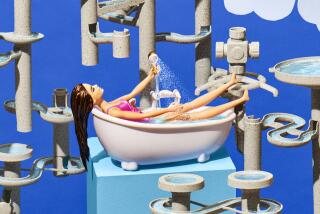Editorial: The L.A. River can’t be all things to all people, but it can be better than what we have now
You do know the water temperature of the Los Angeles River, right?
98.6 degrees.
That little joke among L.A. River enthusiasts is a bit of a head-scratcher at first, until you take a minute to think it over. During most of the year, water that flows down the river and out to sea comes from the Donald C. Tillman Water Reclamation Plant in Van Nuys, and from similar facilities in Burbank and Glendale. And where does their water come from? Well, not to be indelicate about it, but — from us. No, the river isn’t actually body temperature. But it does in fact flow through the people of Los Angeles.
Although L.A. residents never balked at flushing their used, reclaimed and cleaned-up water down the river, some years ago there was a vocal rebellion against further treating that same water, putting it in the ground and then drawing it out again to pipe into their homes. Never mind that the water would be as clean as the stuff that flows to us from distant mountains, which, by the way, also has to be treated. The idea of drinking previously used water just made people say, “Yuck!”
Let’s hope L.A. has gotten over that, especially now, as drought and environmental degradation have reminded us that we need to use whatever precious water we have — over and over again. To that end, city officials are busy working on water reuse projects.
But that leaves us in a new quandary, as set forth in a UCLA study published last September and discussed in a recent story by Times staff writer Deborah Netburn: If we divert to groundwater storage all of the cleaned-up water that flows through us, it will no longer be flowing down the river.
No, the river isn’t actually body temperature. But it does in fact flow through the people of Los Angeles.
That’s a blow to the long-held vision of turning the river into badly needed year-round habitat for birds, fish and amphibians, and at the same time into a playground for the tens of thousands of residents who live near its banks and have little other access to natural areas — and the tens of thousands of visitors who may want to enjoy a wetland park for recreation.
Bound in concrete and the butt of civic jokes, the Los Angeles River had been nothing for anybody for so long that, in the various visions for its reinvention, it became everything to everybody, all the time — wildland, public park, waterfront, storm drain, a sidewalk for smart cafes and bars.
At about the time the UCLA study was coming out last year, a flap was developing over the discovery of toxic bacteria — E. coli, an organism associated most often with human waste — in the river. As reported by public radio station KPCC, government officials knew about the contamination but did not close the portion of the river open to boating, in part because of pushback from the kayaking outfitters that survive on their rental and trip fees.
The incident was a reminder of two things. First, not all human waste goes through Tillman before moving down the river. Some may come from illegal dumping or from homeless residents living on the banks. And second, the river cannot be everything to everybody, all the time. There may be a time for boating, and another time for just watching from the banks.
Still, there is room for multiple benefits and multiple visions. The river functions as the storm drain that engineers intended when they started pouring concrete in the 1930s, and that’s a good thing. The concrete protects the urban region not so much from the year-round outflow from sources such as Tillman but from the raging floods that come during winter downpours in the San Gabriel Mountains.
But there are places where concrete can be safely removed to allow the river to come back to life. It may be a different kind of life if it survives just on seasonal rainwater and not on constant flow of reclaimed water, as some planners had envisioned, but that pattern of wet and dry more closely resembles the sort of seasonal flow that once supported migrating steelhead and other species.
Even the seasonal stormwater flow won’t be as great as it is now, because this thirsty city must capture, clean and reuse much of it, just like the wastewater. But thinkers, planners and builders can surely find a way to ensure enough to pool for recreation, to keep the banks green, and to sustain more wildlife, because all of those things are nearly as crucial as drinking water to a vibrant, healthy city.
Follow the Opinion section on Twitter @latimesopinion and Facebook
More to Read
A cure for the common opinion
Get thought-provoking perspectives with our weekly newsletter.
You may occasionally receive promotional content from the Los Angeles Times.










